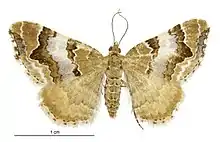Asaphodes obarata
Asaphodes obarata is a moth in the family Geometridae. It is endemic to New Zealand. It is classified as critically endangered by the Department of Conservation.
| Asaphodes obarata | |
|---|---|
 | |
| Male | |
 | |
| Female | |
| Scientific classification | |
| Kingdom: | |
| Phylum: | |
| Class: | |
| Order: | |
| Family: | |
| Genus: | |
| Species: | A. obarata |
| Binomial name | |
| Asaphodes obarata (Felder & Rogenhofer, 1875)[2] | |
| Synonyms | |
| |
Taxonomy
This species was first described by Cajetan Felder and Alois Friedrich Rogenhofer in 1875 as Cidaria obarata.[3] The holotype specimen was collected by Thomas R. Oxley in Nelson and is held at the Natural History Museum in London.[4] Edward Meyrick placed the species within the genus Larentia in 1884.[5] In 1898 George Vernon Hudson placed the species within the genus Xanthorhoe.[6] In 1971 John S. Dugdale assigned Xanthorhoe obarata to the genus Asaphodes.[7]
Description
Hudson described A. obarata as follows:[6]
The expansion of the wings is barely 1 inch. The fore-wings are pale greyish-ochreous ; there is an interrupted reddish-brown transverse band near the base ; two faint, interrupted shaded blackish hues, one at about one-third and the other at about two-thirds, enclosing between them a large central area, which contains a very distinct black dot above the middle, and several irregular shaded black marks; beyond this there is a wavy reddish-brown band; the apex of the wing is somewhat projecting, and the termen is considerably bowed. The hind-wings are pale grey, with a paler central band, and numerous faint, wavy, darker grey lines. The cilia of all the wings are white, banded with dark grey.[6]
Distribution
A. obarata is endemic to New Zealand.[2][8] As well as Nelson, it has been collected in Wellington, Christchurch and at the foot of Mount Hutt.[6] It has also been collected at Waimarino and Ohakune in the North Island as well as Akaroa, Otira, Dunedin, Queenstown and Invercargill in the South Island.[9]
There has been a contraction of range in Dunedin and Southland and this species is now regarded as being locally extinct in both Dunedin and Invercargill.[10][11]
Ecology and habitat
Hudson states that this species could be found on the margins of forests[9] and R. W. Fereday communicated that it was a plain-frequenting species that has an affinity for gorse hedges.[6] Hudson also stated that adult moths were on the wing in December and January.[9]
Host plants
The host plants of this species are unknown.[11]
Conservation status
This moth is classified under the New Zealand Threat Classification system as being Nationally Critical.[1] It has been hypothesised that this species is under threat as a likely result of habitat loss.[12]
References
| Wikimedia Commons has media related to Asaphodes obarata. |
| Wikispecies has information related to Asaphodes obarata. |
- Hoare, R.J.B.; Dugdale, J.S.; Edwards, E.D.; Gibbs, G.W.; Patrick, B.H.; Hitchmough, R.A.; Rolfe, J.R. (2017). Conservation status of New Zealand butterflies and moths (Lepidoptera), 2015 (PDF). Wellington, New Zealand: New Zealand Department of Conservation. p. 5. ISBN 9781988514383.
- "Asaphodes obarata (Felder & Rogenhofer, 1875)". www.nzor.org.nz. Landcare Research New Zealand Ltd. Retrieved 30 April 2018.
- Felder, Cajetan; Rogenhofer, Alois Friedrich (1864–1867). "Reise der österreichischen Fregatte Novara". Reise der österreichischen Fregatte Novara um die Erde in den Jahren 1857, 1858, 1859 unter den Befehlen des Commodore B. von W. pt.9:Bd.2:Abt.2 (1864-1867) Atlas: cxxxiii fig 33 – via Biodiversity Heritage Library.
- Dugdale, J. S. (1988). "Lepidoptera - annotated catalogue, and keys to family-group taxa" (PDF). Fauna of New Zealand. 14: 174. Retrieved 30 April 2018.
- Meyrick, Edward (1884). "A monograph of the New Zealand Geometrina". Transactions and Proceedings of the New Zealand Institute. 16: 49–113. Retrieved 30 April 2018.
- Hudson, G. V. (1898). New Zealand moths and butterflies (macro-lepidoptera). London: Newman & Co. p. 66. doi:10.5962/bhl.title.7912.
- Dugdale, J. S. (10 November 1971). "Entomology of the Aucklands and other Islands south of New Zealand: Lepidoptera, excluding non-Crambine Pyralidae" (PDF). Pacific Insects Monograph. 27: 55–172 – via Bishop Museum.
- Gordon, Dennis P., ed. (2010). New Zealand inventory of biodiversity. Volume two. Kingdom animalia : chaetognatha, ecdysozoa, ichnofossils. Vol. 2. Christchurch, N.Z.: Canterbury University Press. p. 459. ISBN 9781877257933. OCLC 973607714.
- Hudson, G. V. (1928). The Butterflies and Moths of New Zealand. Wellington: Ferguson & Osborn Ltd. p. 121.
- Patrick, Brian H. (2017). "Ecology and conservation of the rare moth Asaphodes frivola Meyrick". The Weta. 47: 17–38. Retrieved 30 April 2018.
- Patrick, Brian; Dugdale, John S. (2000). Conservation status of the New Zealand Lepidoptera (PDF). Wellington, New Zealand: Department of Conservation. p. 20. ISBN 0478218672.
- Brian, Patrick (2000). Conservation status of two rare New Zealand geometrid moths (PDF). Wellington, N.Z.: Department of Conservation. ISBN 0478219466. OCLC 54078998.
